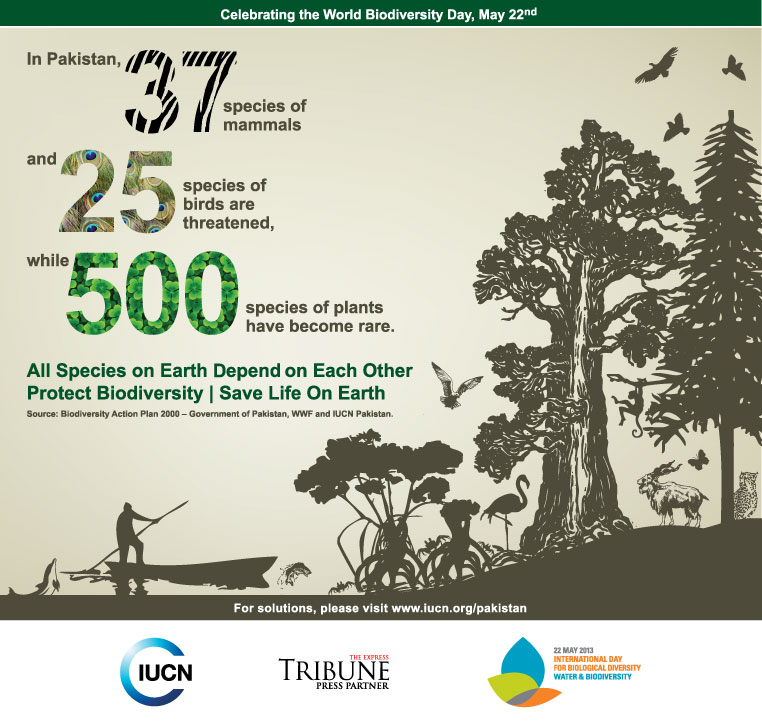Conserving the Diversity of Life - International Day for Biological Diversity
May 22nd has been declared the International Day for Biological Diversity to highlight why we need to stop the biodiversity loss if we were to sustain life on Earth

Photo: IUCN Pakistan
The theme for the year 2013 is Water and Biodiversity, which has been chosen to coincide with the United Nations designation of this year as the International Year of Water Cooperation. The theme brings to the fore how water management is vital for the conservation of biodiversity.
Providing and sustaining water for the needs of people around the world is already a major challenge for sustainable development in both the developed and developing countries. The ecosystems of our world, particularly forests and wetlands, ensure that clean water is available to the animal and plant kingdoms. Wetlands can help reduce risks of flooding, while restoring soils can reduce erosion and pollution, and help increase water availability for the crops. Protected areas can assist in providing water for the cities. These are, but a few examples of how ecosystem management can help us solve water-related problems.
“Flow of water in the rivers is essential to maintain the flora and fauna along the banks of the rivers and delta, therefore IUCN made a strong recommendation to the government for releasing a minimum of 35 million acre-feet of water downstream Kotri barrage”, says Tahir Qureshi, Marine Coastal Expert, IUCN Pakistan.
Pakistan is a country rich in biodiversity, home to more than 1,250 species of plants and animals, however, deforestation, soil erosion, salinity and waterlogging have become major threats to the biodiversity in Pakistan, which has a number of the world’s rarest animals and plants, but these are now in danger from habitat loss and overuse, coupled with rising population. This has put immense pressure on the country’s natural resource base.
“Since humans are the custodians of the earth therefore it is their prime responsibility to use the natural resources equitably for a sustainable future. All species on the earth depend on each other, so by conserving biodiversity we conserve life on earth”, says, Mr. Mahmood Akhtar Cheema, Country Representative, IUCN Pakistan.
Biodiversity Conservation has been the core priority area for IUCN since its inception in 1948. Globally, IUCN has developed key expertise under its Species and the Marine and Polar programmes. The most notable work of IUCN is the IUCN Red List of Threatened Species™, which is widely recognized as the most comprehensive and objective global approach for evaluating the conservation status of plant and animal species. IUCN Pakistan, since commencement of its operations in Pakistan, has successfully implemented numerous biodiversity and water related initiatives. IUCN supports the Government of Pakistan in meeting its obligations as a signatory to the Convention on Biological Diversity (CBD), which is dedicated to promoting sustainable development. The convention recognizes that there is more to biological diversity than plants, animals, micro organisms and their ecosystems – it is about people and our need for food security, medicines, fresh air and water, shelter, and a clean and healthy environment in which to live. For instance, 40% of our medicinal drugs come from wild plants.
IUCN has also joined hands with UNESCO and Balochistan Forest and Wildlife Department to get 111,852 hectares designated as Pakistan’s second Man and Biosphere (MAB) reserve to enable scientific study and robust governance. Once designated, this area will be one of the 610 MAB sites in the world.
Expanding its work to the coast of Sindh, IUCN through the Sindh Coastal Community Development Project has also been involved in training the communities to plant mangroves, monitoring mangrove plantation and assessing the environmental impacts of aquaculture activities undertaken by the Sindh Fisheries Department. In the north, IUCN’s biodiversity conservation work includes, developing the Murree Biodiversity Park, spanning over 17.4 hectares.
However, if we look at the bigger picture, this is just a small drop in the ocean. Pakistan is at a great risk of losing its rich biological heritage; already 37 species of mammals are threatened, along with 25 species of birds, while 500 species of plants have become rare. The need of the hour is to link development frameworks with ecosystem restoration, and biodiversity conservation with livelihood opportunities, and to be able to demonstrate this relationship from policy-to-practice levels.
For more information, please contact:
Madiha Aijaz, Coordinator, Education Communication and Outreach,
Cell: 0345-2004154, email: madiha.aijaz@iucn.org
